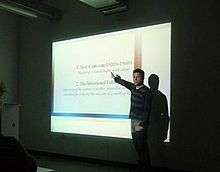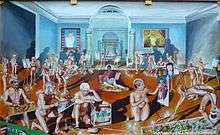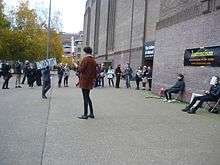Intentism
Intentism is an international art movement that was founded by Vittorio Pelosi.[1] Intentists include artists, writers and philosophers[2] (including Professor William Irwin Kings College, Pennsylvania and Chair Professor of philosophy Paisley Livingston Lingnan University, Hong Kong) from England, Ireland, India, North America, South America, and Hong Kong.[3] Linguist and philosopher Noam Chomsky has described Intentist theory as "intriguing and imaginative".[4]
Intentists have staged various exhibitions[5] and have spoken at Universities[6] including the University of the Arts London. In 2009 their manifesto was published in Intentism - The Resurrection of the author.[7]
Name and origin
Intentists come from a variety of backgrounds but are all questioning ideas related to the meaning of work.[8] The name Intentism is a response to the debate around authorial intent.[9]
Manifesto
Intentists believe that art can convey an artist's intended message to his or her intended audience. As a movement it both recognizes and celebrates the relationship between an artist's creation and its creator.[10]
Intentists believe three principles:[11]
- Intentists believe that the artist is free to convey his or her intended message. The meaning of the work is found in the artist's intention and not the interpretation of the viewer.All meaning is simply the imperfect outworking of intention.[12]
- Intentists believe a confused, hidden or denied intention leads to zero accountability.
- Intentists believe that an omission of artist intention can lead to enforced restrictions on the artist and even censorship.
Public debates and lectures
Intentism has been the subject of several public debates. In 2009 The University of the Arts London held a Panel Discussion around Intentism entitled 'Intentism: Is an artist free to convey his or her intended message?[13] In 2011, The Royal College of Art, held a debate on Intentism named 'Rebirth of the Author?'[14] Intentists have also given several Lectures at various art institutions including The University of East London[15] and the University of Kent.

Intentism and Translation Theory
In 2011 Vittorio Pelosi was interviewed by the University of East Anglia about Intentist theory's relevance to Translation studies.[16]
Intentism and Photography
In Documenting Performance Intentist theory is described as being fundamental to understanding photographic documentation of performance. ″In repositioning the photographer as being as important as the artist or work being documented, the debate should perhaps draw on the school of Intentism as defined by Pelosi.″[17]
Artistic practice
Intentist artists work in numerous ways, but at present there appears to be three areas that are of particular interest. Firstly, Intentists often celebrate the artist's intentions in the work by including the entire process of creating art in the final piece. Consequently, elements of every editing decision is left in.[18] Intentists call this process Palimpsestism and the Intentional Trail.[19] Secondly, since authorial irony can only be understood by comparing what is said (the work), and what is meant (author intent), it is a common subject for Intentist artists. An example here would be Luciano Pelosi’s Big Breakfast. Thirdly, much art theory finds its origin in Literary theory. It is a claim of the Intentists that in certain fundamental areas this cross over is not valid. In literature the author has a linear order expectation for the text since the viewer will normally start at the beginning and read letters sequentially until the end. However, this approach is not appropriate for the static arts. Most paintings and sculptures are anarrative as viewers can approach the work in multiple orders. Therefore, this basis for ignoring the artist’s intentions is not relevant. An example of an Intentist artist creating work to demonstrate these anarrative properties is Govinda Sah.[20]
The School of Postmodernism

Vittorio Pelosi's painting The School of Postmodernism, inspired by Raphael's The School of Athens, is one of the best known paintings to come out of the Intentist movement and replaces all of Raphael's Athenian philosophers with Postmodern icons. Each figure is attempting an objective depiction of the life model, but their work is subjected to their postmodernist ideologies.[21]
Palimpsestism

Maria Beddoes' work combines a chair that has been passed down through generations of her family with a reworking of her grandfather's 1941 art homework. Mixing textiles with graphics and glass, Beddoes work centres on the difference between change of meaning and association as the chair and artwork carries a new intentional significance. The glass work has multiple layers demonstrating Palimpsestism.
Anarrativism
Govinda Sah's generally works with celestial imagery. Depicting numerous constellations makes any visual sequence the viewer might have in studying the work arbitrary.
Exhibitions
Intentists regularly exhibit their work, both in solo Intentist exhibitions and Intentist group shows.[22]

Public demonstrations
Intentists have conducted several demonstrations, most notably outside Tate Britain and Tate Modern, London.[23]

Artists
- Aaron Jell
- Adrian Haak
- Belle Twigg
- Govinda Sah
- Julie North
- Luciano Pelosi
- Maria Beddoes
- Paisley Livingston
- Vittorio Pelosi
References
- ↑ www.vittoriopelosi.webs.com
- ↑ www.intentism.com list of Intentists
- ↑ Croydon Advertiser interview
- ↑ www.intentism.com
- ↑ 1st Angel article on Intentism Exhibition and Conference 2009
- ↑ University of the Arts London Alumni Bulletin
- ↑ www.amazon.com
- ↑ University of the arts London interview
- ↑ Intentism essay in Culture Wars, the online review of the Institute of Ideas, London
- ↑ Manifesto at www.intentism.com
- ↑ Manifesto at www.intentism.com
- ↑ Intentism essay in Culture Wars, the online review of the Institute of Ideas, London
- ↑
- ↑
- ↑
- ↑
- ↑ Newall, H; Skinner, A; Taylor, A (2017) Documenting Performance. Bloomsbury. p. 102
- ↑ 1st Angel article on Intentism
- ↑ Croydon Advertiser Interview
- ↑
- ↑ A Study of the School of Postmodernism
- ↑
- ↑
External links
- Intentism web site
- Culture Wars web site
- Croydon Advertiser Article
- YouTube video of Intentist interview with Professor Colin Lyas
Further reading
- Burke, S (2010) The Death and Return of the Author: Criticism and Subjectivity in Barthes, Foucault, and Derrida Edinburgh University Press, ISBN 0-7486-3711-7 ISBN 978-0748637119
- Gibbs, R.W. (1999) Intentions in the Experience of Meaning Cambridge University Press,ISBN 0-521-57630-X ISBN 978-0521576307
- Hirsch, E.D.Jnr. (1967) Validity in Interpretation Yale University Press, ISBN 0-300-01692-1 ISBN 978-0300016925
- Irwin, W.(1999) Intentionalist Interpretation: A Philosophical Explanation and Defense Praeger, ISBN 0-313-31151-X ISBN 978-0313311512
- Irwin, W. (2002) The Death and Resurrection of the Author? (Contributions in Philosophy) Greenwood Press, ISBN 0-313-32275-9 ISBN 978-0313322754
- Juhl, P.D. (1986) Interpretation: An Essay in the Philosophy of Literary Criticism Princeton University Press, ISBN 0-691-02033-7 ISBN 978-0691020334
- Krausz, M (2002) Is There a Single Right Interpretation? Pennsylvania State Univ Pr, ISBN 0-271-02183-7 ISBN 978-0271021836
- Livingston, P. (2007) Art and Intention: A Philosophical Study Clarendon Press, ISBN 0-19-920429-2 ISBN 978-0199204298
- Lyas, C (2007) Aesthetics (Fundamentals of Philosophy) Taylor and Francis, ISBN 1-85728-580-8 ISBN 978-1857285802
- Pelosi, V (2009) Intentism: Resurrection of the Artist Intentism Publishing House, ISBN 0-9562768-0-6 ISBN 978-0956276803
- Stecker, R (2003) Interpretation and Construction: Art, Speech, and the Law Wiley-Blackwell, ISBN 1-4051-0175-X ISBN 978-1405101752